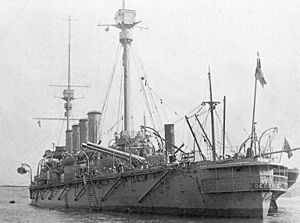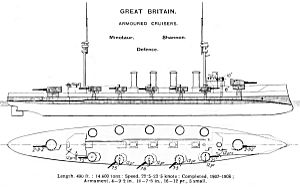HMS Defence (1907) facts for kids

Stern view of Defence
|
|
Quick facts for kids History |
|
|---|---|
| Name | Defence |
| Ordered | 1904-05 Naval Programme |
| Builder | Pembroke dockyard |
| Cost | £1,362,970 |
| Laid down | 25 February 1905 |
| Launched | 24 April 1907 |
| Commissioned | 9 February 1909 |
| Fate | Sunk at the Battle of Jutland, 31 May 1916 |
| General characteristics | |
| Class and type | Minotaur-class armoured cruiser |
| Displacement | 14,600 long tons (14,800 t) |
| Length |
|
| Beam | 74.5 ft (22.7 m) |
| Draught | 26 ft (7.9 m) |
| Installed power |
|
| Propulsion |
|
| Speed | 23 knots (43 km/h; 26 mph) |
| Range | 8,150 nmi (15,090 km; 9,380 mi) at 10 knots (19 km/h; 12 mph) |
| Complement | 779 |
| Armament |
|
| Armour |
|
HMS Defence was a powerful armoured cruiser built for the Royal Navy in the early 1900s. She was the very last armoured cruiser ever made for the Royal Navy. When World War I started, Defence was in the Mediterranean Sea. She took part in chasing the German warships SMS Goeben and SMS Breslau. In January 1915, the ship joined the main British fleet, known as the Grand Fleet.
Defence was tragically sunk on May 31, 1916, during the Battle of Jutland. This was the biggest naval battle of the war. While sailing with the Grand Fleet, Defence tried to attack a damaged German ship. She was hit by powerful shots from a German battlecruiser and four battleships. These hits caused her rear ammunition storage (magazine) to explode. The fire quickly spread to other magazines, causing even bigger explosions. Sadly, almost everyone on board, between 893 and 903 men, died. Only one person, Richard Creath, is known to have survived.
Contents
Ship Design and Features
The Defence was a large ship, weighing about 14,600 tons when built. She was about 158 metres (519 feet) long and 22.7 metres (74 feet 6 inches) wide. Her engines were very strong, producing 27,000 horsepower. This allowed her to reach a top speed of 23 knots (about 43 kilometres per hour). The ship used 24 water-tube boilers to power her engines.
Defence could carry a lot of fuel, including 2,060 tons of coal and 750 tons of fuel oil. This gave her a long range of 8,150 nautical miles (about 15,090 kilometres) when cruising at 10 knots. The ship was designed to have a crew of 779 officers and sailors.
Powerful Guns and Torpedoes
The main weapons on Defence were four large 9.2-inch guns. These were placed in two twin gun turrets, one at the front and one at the back of the ship. For her secondary weapons, she had ten 7.5-inch guns, each in its own turret along the sides of the ship.
To defend against smaller, fast attack boats (torpedo boats), Defence had sixteen 12-pounder guns. She also carried five 17.7-inch torpedo tubes, which fired torpedoes from underwater. One of these torpedo tubes was located at the very back of the ship.
Strong Armour Protection
Defence was built with thick armour to protect her from enemy fire. Her main armour belt, which ran along the waterline, was 6 inches (152 mm) thick in the middle. This thickness gradually decreased to 3 inches (76 mm) towards the ends of the ship.
The gun turrets and their bases (barbettes) were protected by armour between 6 and 8 inches (152–203 mm) thick. The ship's deck had armour that was 1.5 to 2 inches (38–51 mm) thick. The conning tower, where the ship was commanded, had the thickest armour at 10 inches (254 mm).
Building and Service History
Defence was ordered in 1904 as the last of three Minotaur-class armoured cruisers. Her construction began on February 22, 1905, at the Royal Dockyard in Pembroke Dock, Wales. She was officially named and launched on April 27, 1907, by Lady Cawdor. The ship was ready for service on February 3, 1909, and cost about £1,362,970 to build.
Initially, Defence was part of the 5th Cruiser Squadron. She later joined the 2nd Cruiser Squadron and then the 1st Cruiser Squadron. In 1911–1912, she had an important job: escorting the ocean liner RMS Medina. This liner was being used as the royal yacht for King George V's trip to India. After returning to England, Defence was sent to the China Station before being ordered back to the Mediterranean to be the flagship of the 1st Cruiser Squadron.
When World War I began, Defence was involved in chasing the German warships Goeben and Breslau. However, the British admiral decided not to attack Goeben because it had stronger guns and armour. Defence then helped blockade the German ships in the Dardanelles. Later, she was ordered to the Atlantic Ocean to hunt for Admiral Maximilian von Spee's German squadron. This order was cancelled, and she returned to the Dardanelles.
In October, Defence was again sent to the South Atlantic to join a squadron searching for the German ships. However, she only reached Montevideo, Uruguay, when she learned that most of the British squadron had been destroyed at the Battle of Coronel. Defence then met up with the battlecruisers HMS Inflexible and HMS Invincible. She transferred some of her long-range radio equipment to Invincible before sailing to South Africa. From there, she escorted a group of troop ships back to Great Britain. On December 8, she left Cape Town and rejoined the 1st Cruiser Squadron of the Grand Fleet as its lead ship.
Between 1915 and 1916, Defence was updated with new anti-aircraft (AA) guns. A 12-pounder AA gun was placed on the back part of the ship's upper structure, and a 3-pounder AA gun was added at the very rear.
The Battle of Jutland
During the Battle of Jutland on May 31, 1916, Defence was the flagship of Rear-Admiral Robert Keith Arbuthnot. She led the First Cruiser Squadron, which was positioned on the right side of the main British fleet. At 5:47 p.m., Defence and HMS Warrior spotted a German scouting group and began firing. Their shots fell short, and the two ships turned to chase them.
Soon after, they saw the damaged German light cruiser SMS Wiesbaden and moved closer to attack. When Defence and Warrior were about 5,500 yards (5,000 metres) from Wiesbaden, they were spotted by the German battlecruiser SMS Derfflinger and four battleships. These powerful German ships were less than 8,000 yards (7,300 metres) away.
The German ships fired heavily at Defence. She was hit by two groups of shells, which caused the ammunition storage for her rear 9.2-inch guns to explode. The fire from this explosion quickly spread through the ship's passages to the nearby 7.5-inch gun magazines, which also blew up. Defence exploded at 6:20 p.m., sinking with everyone on board.
Defence Today
For a long time, people thought Defence had been completely destroyed by the explosion. However, her wreck was found in 1984 by Clive Cussler and a team from NUMA in the North Sea. In 2001, a team led by archaeologist Innes McCartney explored the wreck. They found that, despite the violent sinking, much of the ship was still in one piece.
Today, Defence and other shipwrecks from the Battle of Jutland are protected sites under the Protection of Military Remains Act 1986. This is to prevent further damage to these important historical sites, which are the final resting places for hundreds of sailors.



